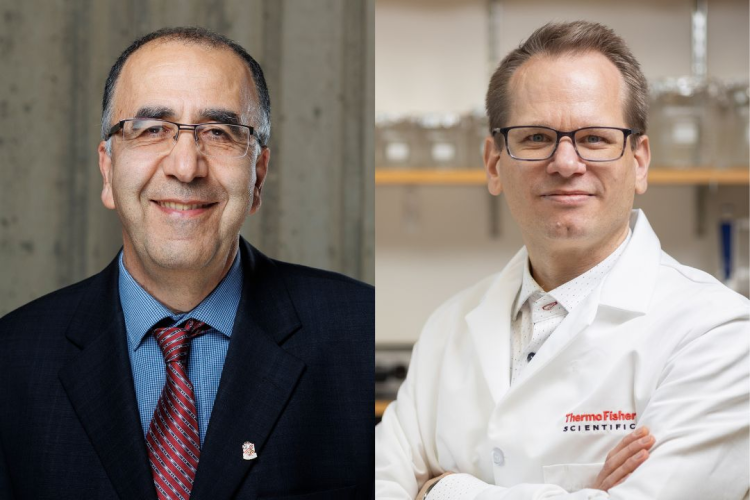University of Saskatchewan (USask) researchers are partnering with the City of Saskatoon to explore new and unique ways to remove micropollutants from water.
Dr. Jafar Soltan (PhD), a professor in the Department of Chemical and Biological Engineering in the College of Engineering, and Dr. Markus Brinkmann (PhD), an associate professor in the School of Environment and Sustainability and the director of USask's Toxicology Centre, are leading the research project that will use a unique chemical process to help deal with micropollutants in wastewater.

USask researchers Dr. Jafar Soltan (PhD) (left) and Dr. Markus Brinkmann (PhD) (right) are leading a project that will use a unique chemical process to help deal with micropollutants in wastewater. (Photos: Submitted)
A micropollutant is a contaminant, typically a man-made chemical one, found in extremely small quantities but still potentially having adverse effects on the environment. While the city's Wastewater Treatment Plant uses multiple layers of advanced filtration and cleaning systems to remove normal pollutants from wastewater, micropollutants are extremely difficult to deal with because of their low reactivity.
"Check the label of your shampoo, and there are usually some chemicals, big name chemicals that are very difficult to pronounce, and many of these are not biodegradable," Soltan said. "Most of these chemicals pass through the wastewater treatment process and end up in the river ... so we said, what can we do about this?"
The USask researchers are working with Mike Sadowski, the manager of Saskatoon's Wastewater Treatment Plant. Sadowski has collaborated with the university on other wastewater projects in the past, including wastewater monitoring during the height of the COVID-19 pandemic and other water purification research with Brinkmann.
"We are excited to continue our partnership with the University of Saskatchewan and support their outstanding research. Projects like this deepen our understanding of emerging contaminants in wastewater, such as pharmaceuticals, and help us shape the future of sustainable water management," Sadowski said. "This work contributes to keeping Saskatoon a great place to live, work and play."
Soltan and Brinkmann are experimenting with advanced oxidation to remove chemicals from wastewater. Part of the wastewater treatment process includes micro-organisms that help consume and break down harmful chemicals, but many micropollutants are resistant to that process.
By using ozone and "free radical" oxygen an unstable oxygen atom that is highly reactive with other chemicals the researchers hope to break down the stubborn micropollutants into pieces that can be processed.
"Radicals are very active. They want to react very quickly with whatever they can find. I call them like a hungry wolf," Soltan said. "Our hypothesis is that these (micropollutants) are good potential feed for these hungry wolves."
Soltan lauded the connection between the city and the university, pointing to the Research Junction program and this project in particular as a display of what can be accomplished when working in tandem. Soltan said the ideal outcome of the project would be to "create new knowledge" to be used in Saskatoon and elsewhere by identifying a new and functional method to deal with micropollutants.
The funding from the Research Junction program will give this research project a kickstart and help with both the exploration of new wastewater treatment processes and the training of new students to further this kind of work.
"This is an ideal example of collaboration between different units of the university as well as the community," Soltan said. "We are building on past activities, and we are planning to solve more relevant and tangible problems in the future."













